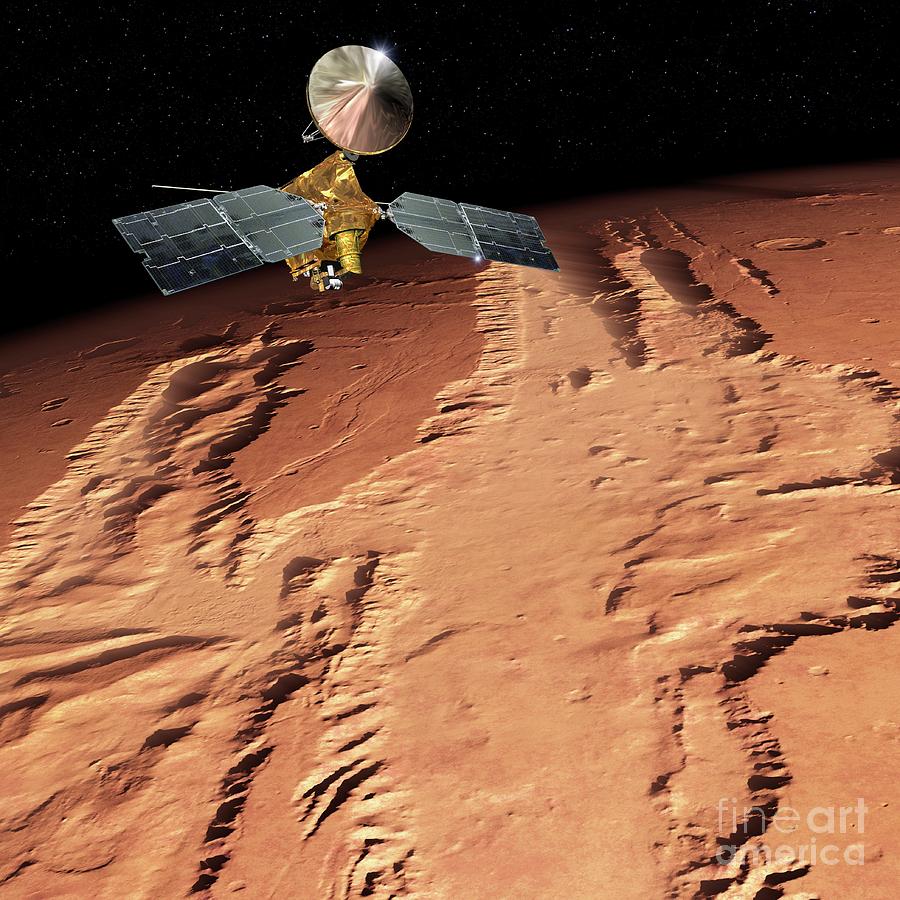
Mars Orbit Insertion - March 2006: The spacecraft approached Mars under the southern hemisphere at an altitude of about 300 kilometers traveling at 3 km/s. The mission was broken into the following phases following launch from earth: Atmospheric Structure Investigation Accelerometers - Data collected from accelerometers during aerobraking would help scientists understand the structure of the Martian atmosphere. Gravity Field Investigation Package - By tracking the orbiter in the primary science phase, team members would be able to map the gravity field or Mars to understand the geology of the surface and near-surface and the geophysical processes that produce these land features. Ka-band Telecommunications Experiment Package - Mars Reconnaissance Orbiter would test the use of a radio frequency called Ka-band to demonstrate the potential for greater performance in communications using significantly less power. If it performed well, similar cameras placed on orbiters of the future would be able to serve as high-precision interplanetary "eyes" to guide incoming spacecraft as they neared Mars. Optical Navigation Camera - This camera was being tested for improved navigation capability for future missions. Electra UHF Communications and Navigation Package - Electra allowed the spacecraft to act as a communications relay between the Earth and landed crafts on Mars that did not have sufficient radio power to communicate directly with Earth by themselves. SHARAD (Shallow Radar) - This sounding radar would probe beneath the Martian surface to see if water ice was present at depths greater than one meter. MCS (Mars Climate Sounder) - This radiometer functioned as an atmospheric profiler to detect vertical variations of temperature, dust, and water vapor concentrations in the Martian atmosphere. Spectrometer: CRISM (Compact Reconnaissance Imaging Spectrometer for Mars) - This instrument would identify minerals, especially those likely formed in the presence of water, in surface areas on. MARCI (Mars Color Imager): This weather camera would monitor clouds and dust storms. CTX (Context Camera): This camera would provide wide area views to help provide a context for high-resolution analysis of key spots on Mars provided by HiRISE and CRISM. HiRISE (High Resolution Imaging Science Experiment): This visible spectrum camera could reveal small-scale objects in the debris blankets of mysterious gullies and details of geologic structure of canyons, craters, and layered deposits. The solar panels charged two Nickel-Hydrogen rechargeable batteries, each with a storage capacity of 50 Ampere-hours. During aerobraking, the solar panels acted as drag brakes, reaching 200 Celsius due to aerodynamic heating. The two panels together produced 1,000 Watts of power at Mars. Eight small MR-103D thrusters, each producing 0.9 Newtons provided back-up attitude control to the reaction wheels and fine during Mars orbit insertion and trajectory correction maneuvers.Įlectrical power was provided by two solar panels, each an area of 10 square meters and contained 3,744 individual solar cells with an efficiency of 26%. Six medium MR-106E thrusters, each producing 22 Newtons, were used for trajectory correction maneuvers, and to the spacecraft during the Mars orbit insertion burn. 
Six large MR-107N thrusters, each producing 270 Newtons, were used for the Mars orbit insertion burn. Over 70% of the propellant would be consumed in the Mars orbit insertion maneuver. The hydrazine monopropellant pressure-fed system included a single tank with a capacity of 1187 kilograms of usable propellant. It could also be used to control the spacecraft's position, as a backup to the primary reaction wheel system. The propulsion subsystem was used for major maneuvers. Span: 13.60 m (44.60 ft).ĭuring its two-year primary science mission, the Mars Reconnaissance Orbiter was to conduct eight different science investigations at Mars, involving global mapping, regional surveying, and high-resolution targeting of specific spots on the surface. Mars Reconnaissance Orbiter was the first spacecraft designed from the beginning for aerobraking to place it into the desired orbit around Mars.ĪKA: MRO.

Home - Search - Browse - Alphabetic Index: 0- 1- 2- 3- 4- 5- 6- 7- 8- 9Ī- B- C- D- E- F- G- H- I- J- K- L- M- N- O- P- Q- R- S- T- U- V- W- X- Y- ZĪmerican Mars orbiter.






 0 kommentar(er)
0 kommentar(er)
